Gazania flowers (Gazania spp.) are popular choices for gardens and landscapes due to their striking beauty, resilience, and low-maintenance nature. Gazania is a flowering plant that belongs to the Asteraceae family that is native to South Africa, these colorful daisy-like blooms add vibrant splashes of color to outdoor spaces.
African Daisies are versatile plants that can be utilized in various garden settings. They are suitable for flower beds, borders, and containers, where their low-growing habit and long blooming periods create a carpet of vibrant colors. These plants are also favored in xeriscape or water-wise landscapes, as they require minimal water once established and can withstand dry spells with ease.
These plants usually have a compact growth habit, forming a clump of rosette-shaped leaves. African Daisies typically reach a height of about 8 to 12 inches (20 to 30 centimeters) and spread to about 12 to 18 inches (30 to 45 centimeters) in width.

The foliage of gazania plants is usually hairy and has a silvery or gray-green coloration. The leaves are narrow and lanceolate in shape and can vary in size from 2 to 6 inches (5 to 15 centimeters) in length. Their fuzzy texture helps to reduce water loss and protect the plant from harsh environmental conditions.
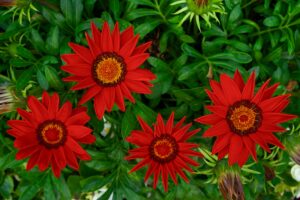
Gazania plants are known for their vibrant and captivating flowers. The flowers are composite inflorescences with a central disk surrounded by colorful ray florets. The disk florets differ in color from the showy ray florets. The ray florets come in a variety of colors such as yellow, orange, red, pink, and white, and may have solid colors or patterns. The flowers have a diameter of 2 to 3 inches and bloom from late spring to fall. They open during the day and close in the evening or on cloudy days, creating a stunning display of color. They often feature contrasting patterns or markings on their petals, adding visual interest and enhancing their beauty.
Cultivars of Gazania Flowers
There are numerous cultivars of Gazania flowers available, offering a wide range of colors, patterns, and characteristics. Here are some popular cultivars:
‘New Day’ series: This series of Gazania cultivars is known for its large, daisy-like flowers in vibrant colors. Varieties within the ‘New Day’ series include ‘New Day Red Shades,’ ‘New Day Yellow Shades,’ ‘New Day Mix,’ and more.
‘Talent’ series: The ‘Talent’ series features compact and well-branched Gazania plants with a profusion of colorful blooms. Varieties in this series include ‘Talent Pink Halo,’ ‘Talent Golden Yellow,’ ‘Talent Flame,’ and others.
‘Big Kiss’ series: The ‘Big Kiss’ series offers Gazanias with large, eye-catching flowers that resemble brightly colored daisies. Cultivars in this series include ‘Big Kiss White Flame,’ ‘Big Kiss Flame,’ ‘Big Kiss Yellow,’ and more.
‘Daybreak’ series: This series showcases Gazania cultivars with large, showy flowers in a range of colors, including orange, yellow, red, and bicolor combinations. Some popular varieties in the ‘Daybreak’ series include ‘Daybreak Red Stripe,’ ‘Daybreak Pink Halo,’ and ‘Daybreak White.’
‘Sunbathers’ series: The ‘Sunbathers’ series features Gazania cultivars known for their heat and drought tolerance. These varieties produce bright, bold flowers in various shades, including red, orange, yellow, and bicolors.
‘Colorado Gold’ series: Gazanias in the ‘Colorado Gold’ series are characterized by their compact growth habit and yellow-gold flowers. Varieties in this series include ‘Colorado Gold Yellow,’ ‘Colorado Gold Orange,’ and ‘Colorado Gold Mix.’
Each cultivar may have specific features, such as flower color, size, pattern, or growth habit. When choosing a cultivar, consider your preferences and the specific growing conditions in your area to select the most suitable Gazania variety for your garden or landscape.
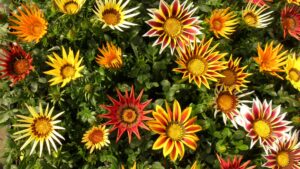
Sunlight Requirement of Gazania Flowers
African Daisy flowers generally require full sunlight to thrive. They are sun-loving plants that prefer bright and direct sunlight for at least 6 to 8 hours a day. In fact, the more sunlight they receive, the better they tend to grow and bloom. When selecting a location for planting gazanias, it’s essential to choose a spot that receives ample sunlight throughout the day. Gazanias can tolerate some light shade, but they perform best when exposed to full sun. In regions with extremely hot and intense sunlight, gazanias may benefit from some afternoon shade to protect them from scorching.
Soil Requirement
Gazanias are adaptable to various soil types, but they thrive in well-drained, moderately fertile soils. Sandy or loamy soils are suitable, with loamy soil being ideal. Good drainage is essential, as waterlogged or clay-heavy soils can cause root rot. Improving drainage can be done with organic matter. Gazanias prefer slightly acidic to neutral soil (pH 5.8-7.0), which can be adjusted using sulfur or lime based on soil test results. Proper pH levels support optimal nutrient absorption. Regular testing and amendments ensure an ideal soil environment for healthy gazania growth.
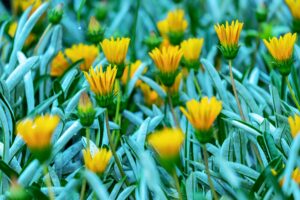
Propagation of Gazania Flowers
Gazania flowers can be propagated through several methods, including seeds, division, and stem cuttings. Here’s a brief overview of each propagation method:
Seeds: Gazanias produce small seeds that can be collected from mature flower heads. After the flowers have faded and dried out, you can gently shake or rub the seed heads to release the seeds. Sow the seeds in a well-draining potting mix, lightly cover them with soil, and keep them moist. Place the pots in a warm, sunny location. The seeds should germinate within a couple of weeks, and once the seedlings have developed a few true leaves, they can be transplanted into individual pots or the garden.
Division: Gazanias can be divided to create new plants. This method is typically done in early spring when the plant is actively growing. Dig up the mature gazania plant and carefully separate the clumps into smaller sections, ensuring that each section has some roots attached. Replant the divisions in well-prepared soil, spacing them apart to allow for growth. Water thoroughly after planting and keep the soil consistently moist until the new plants are established.
Regardless of the propagation method you choose, it’s important to provide the newly propagated gazanias with appropriate care, including regular watering, well-draining soil, and ample sunlight. With proper care, they should establish themselves and grow into beautiful flowering plants.
Water Requirements
To water gazania plants effectively, water deeply and allow the soil to dry slightly between watering. Water once or twice a week during hot, dry periods, adjusting based on local climate and rainfall. Ensure water penetrates the root zone for deeper root growth and drought tolerance. Avoid overwatering and ensure good drainage to prevent waterlogging. Water in the morning to allow foliage to dry and reduce fungal diseases. Avoid watering at night. In cooler periods, water less frequently.
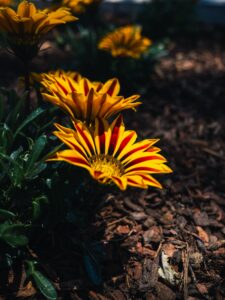
Drought tolerance: Gazania plants are highly drought-tolerant, making them suitable for arid or dry climates. Their deep taproots allow them to access water from deeper soil layers, enabling them to survive periods of water scarcity.
Fertilizer Requirements
Gazania flowers are low-maintenance but benefit from some fertilizer. Prior to planting, enrich the soil with compost or manure. Slow-release fertilizer for flowering plants with an N-P-K ratio of 10-10-10 or 14-14-14 is suitable. Apply during the active growing season, following the packaging instructions for rates and frequency. Dilute the fertilizer in water, avoiding foliage contact to prevent leaf burn. Over-fertilization can cause leggy growth and reduced flowering, so stick to the recommended dosage. Apply at regular intervals, but not more frequently than advised. With proper fertilization, gazanias will thrive and produce abundant blooms.
Deadheading Gazania Flowers
Deadheading gazania flowers is a simple and effective way to promote prolonged blooming and a tidy appearance. Remove faded flowers regularly to prevent energy diversion towards seed production. Pinch or snip off faded flowers at the base, including seed heads, to encourage new blooms. Deadhead as soon as flowers start to fade and inspect plants regularly. Consistent deadheading encourages continuous blooming and maintains an attractive garden.
Problems while growing Gazania Flowers
Gazania flowers are generally hardy and disease-resistant, but they can occasionally be susceptible to certain diseases. Here are a few common diseases that can affect gazanias and some control measures to help prevent or manage them:
Powdery mildew: Powdery mildew appears as a white, powdery coating on the leaves and stems of the plants. It thrives in humid conditions. To control powdery mildew provide good air circulation by spacing the plants properly. Avoid overhead watering; instead, water at the base of the plants. Apply fungicidal sprays specifically formulated for powdery mildew as a preventive measure or at the first sign of the disease.
Botrytis Blight (Gray Mold): Botrytis blight causes brown spots and decay on the flowers and foliage. To manage botrytis blight. Remove and dispose of infected plant parts promptly to prevent further spread. Avoid overhead watering and ensure proper spacing to improve air circulation. Apply fungicidal sprays labeled for botrytis blight, following the instructions.
Aphid Infestation: Aphids are small, soft-bodied insects that can feed on the sap of gazania plants, causing distortion and stunted growth. To control aphids monitor the plants regularly and inspect the undersides of leaves for aphid presence. Use a strong jet of water to dislodge aphids from the plants. If necessary, apply insecticidal soap or horticultural oil following the product instructions.
Spider Mites: Spider mites are tiny pests that suck the sap from leaves, causing yellowing, stippling, and webbing. To control spider mites increase humidity by misting the plants regularly, as spider mites thrive in dry conditions. Use a strong stream of water to wash off spider mites from the foliage.
Whiteflies: Whiteflies are small, winged insects that suck plant sap and can cause yellowing, wilting, and stunted growth. To control whiteflies use yellow sticky traps to monitor and capture adult whiteflies. Apply insecticidal soap or neem oil following the product instructions.
It’s important to note that prevention and good cultural practices play a significant role in maintaining healthy gazanias. Providing adequate sunlight, proper watering, and well-draining soil, as well as regular removal of dead or diseased plant material, can help prevent disease issues. Additionally, selecting disease-resistant cultivars can be a proactive measure to reduce the risk of disease attacks on gazanias.
Uses of Gazania Flowers
Ornamental Flower Beds: Gazanias’ bright and colorful daisy-like flowers make them popular choices for ornamental flower beds. They can be planted in groups or mixed with other annuals and perennials to create eye-catching displays of color.
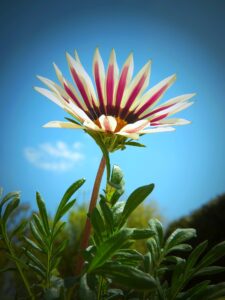
Rock Gardens: Gazanias thrive in sunny, well-draining locations, making them well-suited for rock gardens. Their low-growing, spreading habit and drought tolerance make them excellent ground cover in rocky or sandy areas.
Container Planting: Gazanias work well in containers and hanging baskets, adding a burst of color to patios, balconies, and porches. Their compact growth habit and continuous blooming make them ideal for container gardens.
Coastal Gardens: Gazanias are well-adapted to coastal conditions, tolerating salt spray and sandy soils. They can be used to add color to beachside gardens and coastal landscapes.
Erosion Control: Due to their ability to spread and form dense mats, gazanias can be used for erosion control on slopes and embankments. Their deep root systems help stabilize the soil and reduce erosion.
Pathway Edging: The low-growing and spreading habit of gazanias makes them suitable for edging along garden pathways and walkways. They create a neat and colorful border, defining the pathways.
Pollinator Gardens: Gazanias attract pollinators, such as bees and butterflies, with their nectar-rich flowers. Including gazanias in pollinator-friendly gardens can help support local insect populations.

Water-Wise Landscapes: Gazanias are drought-tolerant once established, making them valuable additions to water-wise and xeriscape gardens. They require less water compared to some other flowering plants, making them environmentally friendly choices.
Cut Flower Arrangements: Gazania flowers can also be cut and used in floral arrangements, adding a touch of brightness and cheer to indoor spaces.



